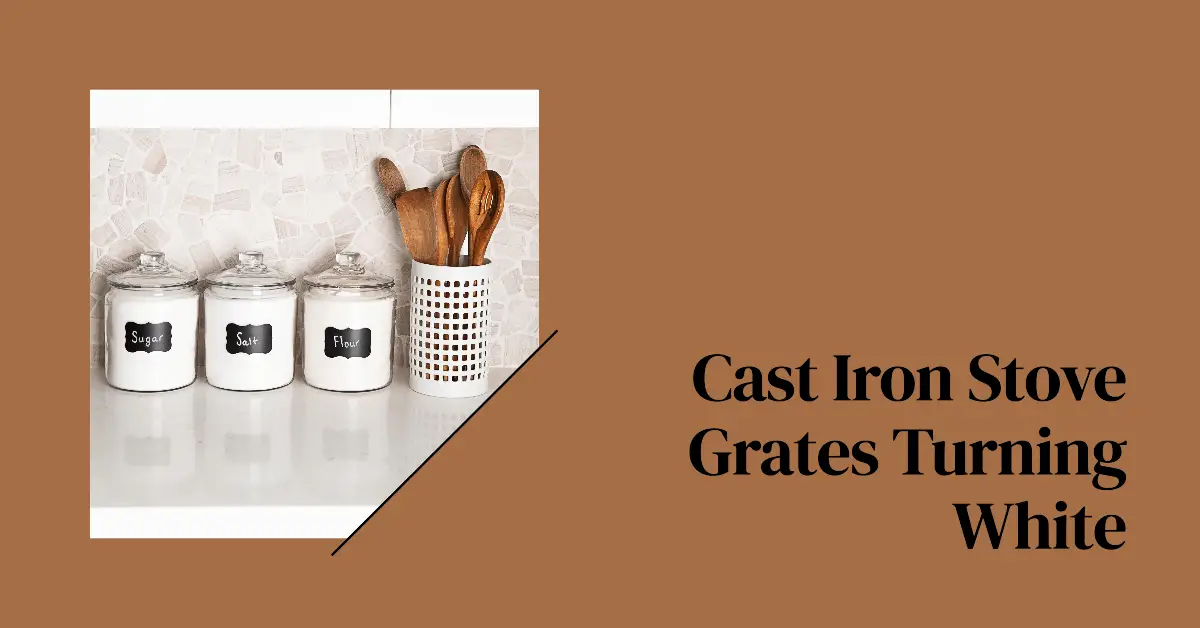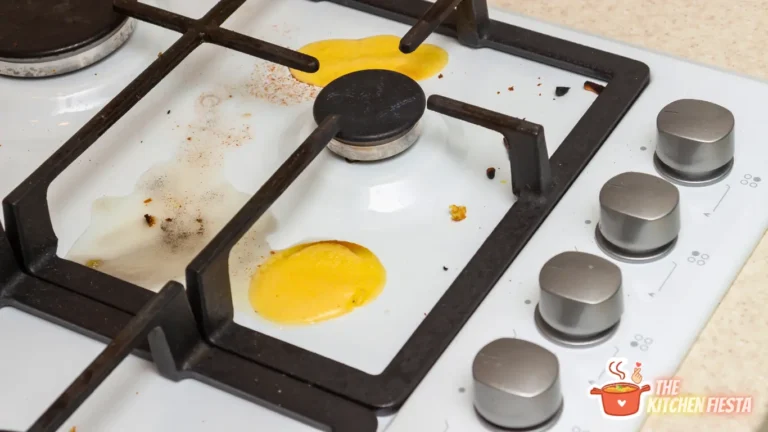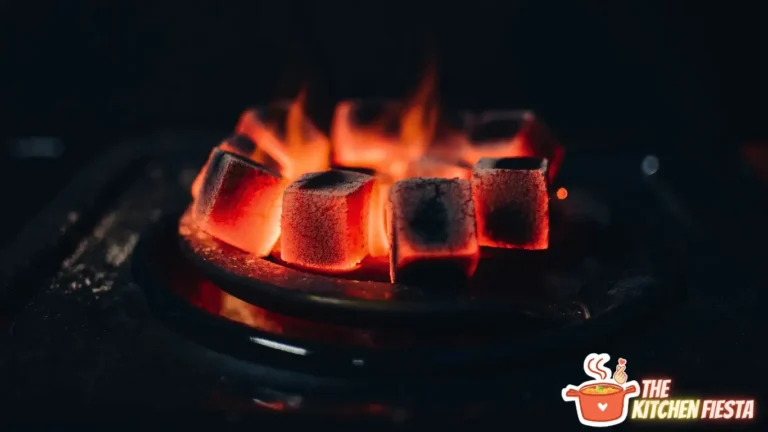Why Are My Cast Iron Stove Grates Turning White?

If you’ve noticed your cast iron stove grates developing light colored stains or a chalky residue, you’re not alone. Many stove owners find their burner grates and cast iron oven grates turning white or gray over time. But don’t worry – with the right cleaning methods and care, you can restore the beautiful black finish of your cast iron grates.
So why exactly do cast iron stove grates turn white in the first place? The discoloration is usually caused by baked on grease, food residue, hard water deposits, and mineral buildup. Porcelain enamel coated grates can also get scratched and worn down from regular use. Uncoated cast iron will naturally develop a very light oxidization as well. With daily heating and cooking, it’s easy for grates to become stained without proper maintenance.
The good news is that you can often remove white stains and restore the dark color of your cast iron grates. With some elbow grease and the right gentle cleaners, you can get your stove grates looking like new again. Proper seasoning and care will also help prevent future discoloration.
In this detailed guide, we’ll cover:
- What causes cast iron stove grates to turn white
- The best cleaning methods for removing white residue
- Tips for cleaning gas stove grates and grates on a Wolf range
- How to season and care for cast iron grates
- When it’s time to replace heavily damaged grates
- Steps for maintaining other areas of a cast iron stove
So whether your cast iron grates are coated with porcelain enamel or completely bare, read on to learn how to clean burnt on stains, prevent future discoloration, and keep your stove looking its best for years to come.
What Causes Cast Iron Stove Grates to Turn White?
Cast iron is beloved for its durability and even heating. But the dark black finish of cast iron grates can become discolored over time with regular use. Here are some of the most common culprits of white, gray, or chalky looking stove grates:
Baked On Grease and Food Residue
Like any heavily used cookware, cast iron stove grates easily become coated in grease splatters, baked on food spills, and sticky residues over time. The high heat of stovetop burners bakes these food particles onto the metal, leaving discoloration and stains. Any spills or drips that aren’t wiped up right away can leave permanent marks.
Acidic foods like tomatoes or lemon juice can etch light scratches or pitting into the enamel coating of coated grates when burned on. Sugary spills that aren’t cleaned promptly can also caramelize onto the grates. These food stains bond tightly to the metal and gradually build up.
Hard Water Deposits and Mineral Buildup
Hard tap water containing minerals like calcium and magnesium will also leave its mark on your stove grates. As water evaporates, it leaves behind white mineral deposits that give the grates a cloudy, chalky appearance.
Similarly, other household minerals from water or cleaners can build up on the grates over time. This creates a gritty residue that affects the appearance.
Wear and Tear on Enamel Coatings
Many cast iron stove grates have a protective porcelain enamel coating. This glass-like coating gives the grates a smooth, easy to clean surface. However, the enamel can become damaged with regular use.
As pots and pans scrape across the grates, the enamel slowly wears down. Tiny scratches and chips expose the bare metal underneath. This allows rust and stains to take hold. Old enamel coatings have often darkened from years of heat exposure as well.
Without the protective coating, iron grates will gradually oxidize and change color with exposure to air. Damaged enamel also allows food and grease to accumulate more easily.
Oxidation of Bare Cast Iron
On grates without any enamel coating, the natural cast iron will slowly oxidize and change color over many years of use. This causes uncoated cast iron grates to lighten slightly in areas from the iron reacting with oxygen.
Exposure to regular high heat speeds up this process. Small brownish oxidation spots may form, eventually blending together into an overall lighter grayish tone. While totally natural, many people prefer the dark black finish of seasoned cast iron.
Now that you know what causes white stains on stove grates, let’s look at the best ways to clean buildup and restore the dark finish.
Cleaning Tips for Removing White Residue From Grates
Cleaning burnt on stains from cast iron grates requires some patience and elbow grease. But with non-abrasive cleaners and thorough rinsing, you can safely remove residue without damaging the enamel.
Here are some of the best methods for cleaning white stains from stove grates:
Make a Baking Soda and Water Paste
For light staining, a baking soda paste is a gentle but effective abrasive cleaner. The alkaline soda helps break down grease, food residue, and some mineral deposits.
To use it, mix a tablespoons of baking soda with just enough water to form a spreadable paste. Apply this paste to stained grates and let it sit for at least 15 minutes before scrubbing. The paste will bubble and react with grime. Scrub stains with a damp cloth or plastic bristle brush.
Rinse the grates thoroughly with hot water and dry well. Baking soda can leave behind a white film if not fully rinsed.
Soak Grates in Hot Soapy Water
For grates with heavy buildup, start by soaking the grates to loosen debris. Place cast iron grates in a large sink or basin filled with hot water and a few tablespoons of dish soap or degreaser. Allow them to soak for 30 minutes up to a few hours.
Then firmly scrub the grates with a plastic or nylon brush to lift grime from the crevices. Soaking softens stubborn grease stains for easier cleaning. Be sure to fully rinse and dry the grates after soaking.
Use a Vinegar Bath
Like baking soda, vinegar slightly breaks down mineral deposits for a deeper clean. Fill your sink with equal parts distilled white vinegar and hot water. For stronger cleaning power, use full strength vinegar.
Allow the stained grates to soak in the solution for 30-60 minutes. Then scrub away any remaining residue with a damp cloth or soft brush. Rinse very thoroughly – vinegar can give off strong odors if left behind.
Remove Stubborn Stains Gently with Steel Wool
For really stubborn white stains on uncoated cast iron, very gently rub the area with 0000 grade steel wool. The fine steel fibers will lightly abrade deposits without damaging the iron. Use a circular polishing motion.
Avoid applying too much pressure, and never use steel wool on coated/enameled grates. It can scratch the coating. Rinse and dry grates well after scrubbing.
Use a Mild Abrasive Cleaner
For porcelain enamel grates, a mild abrasive cleaner like Bar Keeper’s Friend can help remove burned on stains without damaging the enamel. Apply a small amount of powdered cleaner to a damp sponge or cloth. Gently scrub stained areas using minimal pressure. Avoid cleaners with harsh, gritty textures.
Thorough rinsing is key for all cleaning methods. Any residue left behind can quickly re-stain the grates. Be patient, allow ample soak time, and scrub gently to lift stains without wearing down the enamel over time.
How to Clean Burner Grates on a Gas Stove?
The burner grates on a gas stovetop see constant high heat and plenty of spills. Keeping them clean not only improves appearances, but also allows for better heat transfer while cooking. Follow these steps to clean gas stove grates:
Remove and Allow to Cool
Before cleaning, always disconnect the gas line and allow grates to fully cool after use. Never run grates under water while hot – rapid cooling can damage the cast iron.
Carefully remove grates from the stove and inspect for problem areas. Use a plastic spatula to scrape off any chunks of stuck-on food before cleaning.
Degrease Heavily Soiled Areas
For stubborn grease stains, apply a degreasing cleaner like Fantastik or Formula 409 to burnt areas. Let it soak for 10-15 minutes before scrubbing. The degreaser will penetrate and lift greasy buildup.
Use a stiff nylon brush or balled up aluminum foil to gently scrub the soiled cooking surface. Take care not to damage the enamel.
Finish by rinsing both sides of the grates with hot water to remove all traces of degreaser – any residue left behind can affect food flavor.
Scrub with Baking Soda Paste
For light stains on gas stove grates, scrubbing with a baking soda and water paste works well. Apply paste to a damp sponge or cloth and rub into stained areas using minimal pressure.
Rinse thoroughly, then dry the grates completely with a towel to prevent future rusting.
Re-Season Cast Iron Grates
On uncoated cast iron grates, maintain the protective seasoning by wiping a very thin layer of cooking oil onto the clean grates. Apply using a paper towel or clean cloth. Rub over entire cooking surface.
Buff off any excess oil residue with a second dry cloth. This oil helps prevent rusting while adding a fresh layer of seasoning. Avoid oil buildup.
With regular cleaning after each use and re-seasoning, you can keep gas stove grates looking like new.
Tips for Cleaning Grates on a Wolf Stove
Wolf ranges are beloved for their commercial-grade cast iron grates. But like any heavily used cookware, their grates require proper care and cleaning. Here are some tips for keeping Wolf stove grates looking pristine:
Clean Spills Promptly
Wolf’s cast iron grates have either a porcelain enamel coating or are uncoated. Like any cast iron, food spills can bake onto the surface and quickly stain if left untouched.
After each use, allow the grates to cool. Then use paper towels to wipe up any food debris or drips. This prevents stains from setting in over time.
Use Gentle Cleaners
According to Wolf’s recommendations, you should only use non-abrasive cleaners on their grates. Harsh chemicals can damage the enamel, while coarse scouring pads can scratch uncoated iron.
Wolf does not suggest painting burner grates or using wire brushes. These can chip enamel and remove seasoning.
Instead, make a paste of 3 parts baking soda to 1 part water. Apply this paste to grates and let set for 15 minutes before scrubbing clean. The baking soda formula is gentle but lifts stains effectively.
Finish by rinsing well and thoroughly drying grates to avoid moisture damage to cast iron.
Avoid Soaking Grates in Water
While soaking can help loosen baked on grease, Wolf recommends avoiding submerging their grates in water. Water can seep into tiny cracks in the metal and lead to rust formation over time.
Instead, soften stuck-on debris by laying a soaked paper towel over the area for 10-20 minutes. Then scrub clean.
Season and Dry Unglazed Grates
For Wolf’s unglazed cast iron grates, occasionally rub a very thin layer of high smoke point oil onto the cook surface while the grates are still warm. This helps maintain the seasoning and prevent rust.
Always be sure to fully dry unglazed grates before replacing to prevent moisture damage. A quick buff with a dry towel after rinsing prevents water spots.
By using Wolf’s approved cleaning methods and promptly removing spills, you can maintain the beauty of your stove’s grates for many years.
Best Practices for Keeping Cast Iron Stove Grates Looking New
Once you’ve removed white stains from your grates, proper maintenance will keep them looking pristine far into the future. Follow these best practices for cast iron grate care:
Wipe Spills Immediately After Cooking
Don’t give stains a chance to set in. After using your stove, allow the grates to cool slightly and use a dry paper towel to wipe up any visible food spills or grease drips.
This simple habit prevents residue from bonding tightly to the iron over time. It takes just seconds and makes cleaning much easier.
Use Non-Abrasive Cleaners
To remove any leftover debris, regularly clean grates with a soft sponge, damp cloth, or plastic bristle brush. Avoid abrasive scouring powders or metal scrubbers that can scratch enamel coatings.
Baking soda or a mild dish soap work well for most cleaning needs. Soak in hot water to loosen anything stuck-on.
Hand Wash and Dry Thoroughly
Cast iron can rust if left wet. Never put grates in the dishwasher. Hand wash with hot soapy water and rinse very well.
Dry immediately with a towel – don’t let air drying leave moisture behind. Promptly putting grates back after cleaning prevents rust as well.
Re-Season Cast Iron Regularly
Keep uncoated cast iron grates well-seasoned by occasionally rubbing a thin layer of high smoke point oil over the surface. This protects the iron from rust and gives a beautiful patina over time.
Do this after cleaning while the grates are still slightly warm – the heat helps the oil bind properly. Buff off any excess.
Avoid Cooking Very Acidic Foods
Foods with high acid content like tomatoes, citrus, or wine can eat away at enamel over time if dripped and baked on. opt for nonstick cookware when cooking acidic ingredients to avoid etching the enameled surface.
By making stove grate care a habit after each use, you’ll prevent stains in the first place. Consistent, gentle cleaning helps grates maintain their appearance.
When to Consider Replacing Your Stove Grates?
With proper maintenance, quality cast iron stove grates can last for many years. But at a certain point, stained or damaged grates may need to be replaced for optimal performance.
Here are some signs it may be time for new stove grates:
Rust Formation
While surface oxidation is normal on bare cast iron, deeper rust indicates a loss of protective seasoning. If rust cannot be removed, grates should be replaced. Rust can flake into food.
Large Chips, Cracks, or Holes
Enamel coatings can chip from repeated impact or abrasion. Large chips that expose bare metal call for replacement, since rust will form. Likewise, cracks or holes from impact damage can allow spills to seep into the grate.
Severely Discolored or Stained Surface
Heavy discoloration, etching, or stains that cannot be removed with cleaning may mean the protective enamel is too far gone. Without a smooth surface, grates don’t cook evenly or look very appealing.
Excessive Wobbling
Stove grates should sit securely and not rock back and forth on burners. If grates don’t make solid contact with the stove, replacement is needed for safety.
Difficulty Removing Residue
If food and grease bake on very easily and you find cleaning becoming more difficult, the enamel finish may be too degraded to be practical. New grates will restore non-stick properties.
Depending on your manufacturer, you may be able to order replacement grates directly from the company. Be sure to get the right model for your exact stove to ensure proper fit.
There are also many aftermarket grate options available. Companies like Replacements, LTD allow you to find grates for most major brands. They can even provide custom refinishing on cast iron grates.
While pricy, replacing severely damaged stove grates restores the ease of use and aesthetic appeal of your range. Preventing premature wear through regular cleaning helps extend the lifespan of quality grates.
Maintaining Other Parts of a Cast Iron Stove
Cast iron grates aren’t the only components that need routine care on a stove. Follow these maintenance tips for other cast iron pieces:
Cast Iron Burner Caps
Gently clean burner caps with warm soapy water or baking soda paste. Avoid abrasives. Allow to fully dry after cleaning.
Use a cotton swab dipped in rubbing alcohol to clear any blocked burner holes. This maintains even flames.
Cast Iron Oven Surfaces
Wipe down oven walls and doors with a soft cloth and hot soapy water. For stubborn grease, use a baking soda paste.
Avoid oven cleaners, as these can damage porcelain enamel interiors over time.
Porcelain Oven Interiors
Clean porcelain enamel oven interiors with a mix of dish soap and hot water. Allow far spills to soak for easier cleaning. Gently scrub with a plastic brush or sponge.
Avoid using abrasive scouring powders or metal scouring pads inside the oven, as these scratch porcelain.
By regularly maintaining all your stove’s cast iron parts, you’ll keep your range looking fantastic and functioning at its best.
In Conclusion:
With a little detective work to determine the cause, the right cleaning methods, and consistent care, you can keep your cast iron stove grates free of burnt on residue and white stains. While chipping enamel and excessive wear will eventually necessitate replacement, quality grates should last for many years with proper maintenance. Keeping all parts of your cast iron stove clean makes cooking safer and more enjoyable.






